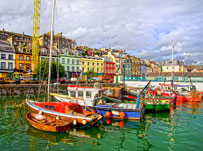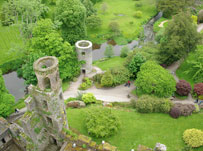Top 10 things to do in and around Cork
Below are our top ten recommendations for things to do in and around Cork. They’ll help you learn about the city, and the region, and give you ample opportunity to practise your English.
1. Do some shopping on St Patrick’s Street
Cork’s main road, St. Patrick Street, is lined with a variety of shops and cafes, and has become one of the main shopping areas in the city. In fact, since its redevelopment in 2004, it has twice won the award as Ireland’s best shopping street! Even if you don’t want to buy anything, it’s worth visiting area to soak up the buzzing atmosphere – you might even be able to catch a street performance or two.
2. Take a stroll around Fitzgerald’s Park
To the west of the city centre is Fitzgerald Park. Bordered by the River Lee to the north, it offers a fantastic view of Sunday’s Well, the affluent suburb situated on its high escarpment. Apart from the array of flora and fauna, the park boasts a number of sculptures and statues, including the one of ‘Boy with boat’ on the small pond. Also located within the park is the Cork Public Museum, where you can find out about Michael Collins, or Cork’s role in the War of Independence.
3. Explore the English Market
One of Cork’s most popular attractions, the English Market has entrances on Princes Street, Patrick Street and the Grand Parade. It is a covered market selling foods from all over the world as well as traditional local produce, including Cork favourites crubeens (pigs’ feet), and Tripe & Drisheen. The origins of the market can be traced back to the 17th century, but the present building dates from 1786. In 1980 it was destroyed by fire and was refurbished by Cork Corporation to an award-winning design by the Cork city architect T. F. MacNamara.
4. Take a trip to Cobh 
Cobh is a colourful harbour town in east county Cork, just half an hour by train from Cork city. It has a rich maritime history, and was the departure point for many emigrants who left the island for America, especially in the Famine years of 1844-48. It was also the last port that Titanic called at before embarking upon its ill-fated journey. One of Cobh’s most famous features is St Coleman’s Cathedral, which is home to the largest bell in Ireland, and from where you can get a beautiful view of the surrounding countryside and coastline.
If you visit Cobh in the summer, you might also get to see the famous regatta. It is one of the oldest in Europe, and is still a sight to be behold! There’s a definite party atmosphere during the regatta too, which will give you a great insight into this aspect of Irish culture.
5. Visit St. Ann’s Church
The Church of St Ann is located in the historic Shandon district of Cork. It is situated a top a hill overlooking the River Lee.The church is famous for its eight bells, which feature in a famous song, “The Bells of Shandon” by Francis Sylvester Mahony, and which you can actually ring yourself when you visit! You can also get a fantastic view over the city from the church’s tower.
6. Kiss the Blarney Stone 
Just outside Cork lies Blarney Castle, home of the famous Blarney Stone. The stone is also known as the ‘Stone of Eloquence’, as it is said to bestow eloquence upon those who kiss it – in other words, anyone who kisses the stone will get the ‘gift of the gab!’
Aside from the Blarney Stone, the castle is also home to the Rocklose Gardens, which are filled with rock formations. There is also a mansion, known as Blarney House, which is open to all.
7. Take in some sport
Gaelic sports, such as Gaelic football and hurling, are played extensively in Ireland, and lots of games are held at Cork’s Pairc Ui Chaoimh Stadium. Horse racing and greyhound racing are also a popular form of entertainment in the city, and can be watched regularly throughout the year.
8. Enjoy some walking in the nearby countryside
Close to Cork, around an hour’s drive away, are the Galtee and Knockmealdown mountain ranges. The scenery there is spectacular, and there are endless opportunities for hiking and biking that will enable you to enjoy Ireland’s Great Outdoors.
9. Take a walk around the Hugenot Quarter
The Huguenot Quarter of Cork is the area around French Church Street and Carey’s Lane.
The Huguenots were French Protestants who fled from religious prosecution in the 17th and 18th centuries. They played an important part in Cork life, and many of them served as sheriffs or mayors of the city, although many more were merchants, manufacturers and gold and silver smiths. The area where they lived is now an attractive district of narrow, cobbled lanes that are brimming with restaurants, cafes, boutiques and galleries.
10. Spend an evening enjoying the ‘craic’ in Cork’s numerous pubs
Ireland is famous for its traditional pubs, and you’ll be spoilt for choice when it comes to spending an evening out. Irish pubs are famous the world over for their atmosphere, and often they’ll have live music to enjoy along with the ‘craic’ as they say in Ireland! You can find detailed listings of the pubs in Cork on the Cork Guide website.
Cactus offers a range of English courses in Cork, including General English, Intensive English, Individual English, Combined English, Business English, Academic Year English, Exam Preparation English, Teacher Refresher English and Juniors English. For full details, including start dates and prices, please visist the Cactus Language website.
